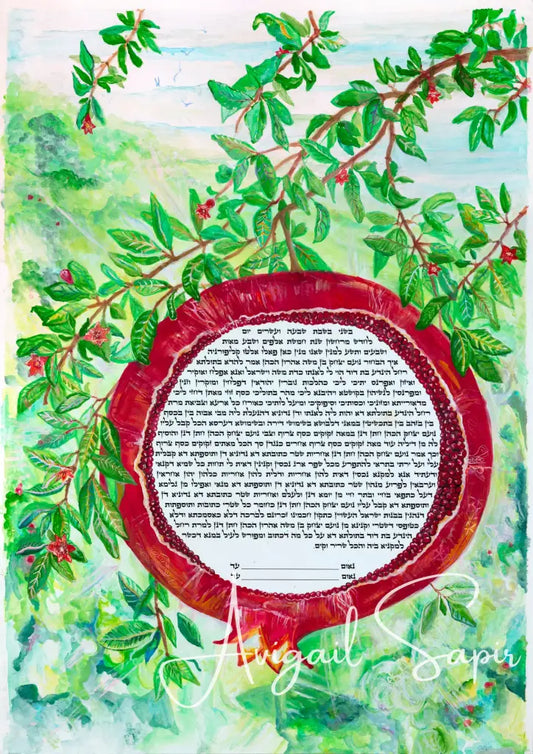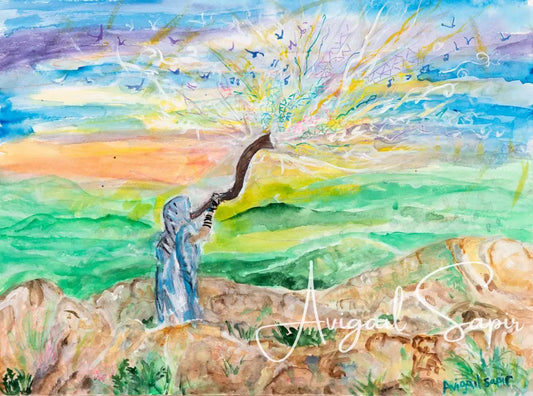Make Your Moment Last Forever
-
"Bursting Red Pomegranate" Personalized Ketubah
Regular price From $300.00 USDRegular priceUnit price per -
"Beyond Words"
Regular price From $65.00 USDRegular priceUnit price per
Rosh Hashanah Art: A Reflection of Diversity, Creativity, Evolution, and Expression
Rosh Hashanah is the Jewish New Year, a time of celebration and reflection. It is also a time of artistic expression, as many people create or enjoy various forms of art related to the holiday. In this essay, I will explore three aspects of Rosh Hashanah art: its diversity and creativity across different countries and communities, its evolution and innovation over time, and its personal and communal expression.
Diversity and Creativity
Rosh Hashanah is celebrated by Jews all over the world, who have developed their own unique artistic expressions and styles. Rosh Hashanah art reflects the cultural diversity and creativity of the Jewish people, as well as their adaptation to different historical and geographical contexts. Some examples of Rosh Hashanah art from different countries and communities are:
- Morocco: A painting by Eliasaf Myzels depicts a Moroccan Jewish family celebrating Rosh Hashanah in their home. The painting shows the rich colors and patterns of Moroccan textiles and ceramics, as well as the traditional foods and customs of the holiday. The painting also captures the warmth and joy of the family gathering, as well as the religious significance of the shofar blowing and the blessing of the children.
- Ethiopia: A sculpture by Avishai Mekonen shows an Ethiopian Jewish woman blowing a shofar made from an antelope horn. The sculpture reflects the ancient and distinctive tradition of Ethiopian Jews, who have preserved their identity and faith for centuries in isolation from other Jewish communities. The sculpture also expresses the resilience and courage of Ethiopian Jews, who have faced persecution and hardship in their homeland, and have immigrated to Israel in recent decades.
- India: An embroidery by Rachel Cohen illustrates a scene from Rosh Hashanah in India. The embroidery shows the vibrant colors and intricate designs of Indian textiles and jewelry, as well as the exotic fruits and flowers that adorn the table. The embroidery also depicts the diversity and harmony of Indian Jews, who belong to different ethnic groups and regions, but share a common heritage and faith.
Evolution and Innovation
Rosh Hashanah art has changed and adapted to different historical contexts and technological developments. Rosh Hashanah art reflects the evolution and innovation of the Jewish people, as well as their interaction with other cultures and influences. Some examples of Rosh Hashanah art from different periods and mediums are:
- 18th century: A painting by Moritz Daniel Oppenheim shows a traditional European Jewish family celebrating Rosh Hashanah in their home. The painting depicts the classical style and elegance of the 18th century, as well as the customs and rituals of the holiday. The painting also reveals the social status and identity of European Jews, who were emancipated and integrated into society, but still maintained their distinctiveness and traditions.
- 21st century: A digital art by Avital Art shows a futuristic Jewish cityscape with a flying shofar. The digital art demonstrates the modern style and technology of the 21st century, as well as the imagination and vision of the artist. The digital art also conveys the continuity and innovation of Jewish culture, which has survived and thrived in various times and places, but still looks forward to the future.
- Mixed media: A collage by a group of Jewish women uses images and words to represent their hopes and wishes for the new year. The collage combines different materials and techniques, such as paper, fabric, paint, glue, scissors, stamps, stickers, etc. The collage also expresses the diversity and creativity of Jewish women, who have different backgrounds and experiences, but share a common bond and vision.
Expression
Rosh Hashanah art can be a way of conveying one’s feelings, thoughts, or beliefs about the holiday and its meaning. Rosh Hashanah art reflects the personal and communal expression of the Jewish people, as well as their inspiration or challenge for their spiritual journey. Some examples of Rosh Hashanah art from different forms of expression are:
- Music: A song by Leonard Cohen is based on the Unetaneh Tokef prayer, which is recited on Rosh Hashanah and Yom Kippur. The song captures the solemnity and beauty of the prayer, as well as the existential questions and emotions that it raises. The song also interprets the prayer in a personal and poetic way, as well as in a universal and humanistic way.
- Poetry: A poem by Jane Hirshfield describes the ritual of Tashlich, which involves casting away one’s sins into a body of water on Rosh Hashanah. The poem evokes the imagery and symbolism of the ritual, as well as the feelings and thoughts that it provokes. The poem also explores the paradox and complexity of the human condition, as well as the possibility and hope of transformation.
- Poster: A poster by Yael Buxbaum uses the image of a honeycomb to convey the idea of social justice and collective action. The poster illustrates the connection between Rosh Hashanah and the Jewish value of tikkun olam, which means repairing the world. The poster also encourages the viewers to join the campaign for fair trade honey, which supports the rights and welfare of beekeepers and bees.
Conclusion
Rosh Hashanah art is a rich and diverse field of artistic expression, which reflects the cultural, historical, personal, and communal aspects of the Jewish people and their faith. Rosh Hashanah art can also be a source of inspiration, guidance, or challenge for one’s spiritual journey. By exploring and appreciating Rosh Hashanah art, we can learn more about ourselves, our heritage, and our world.




